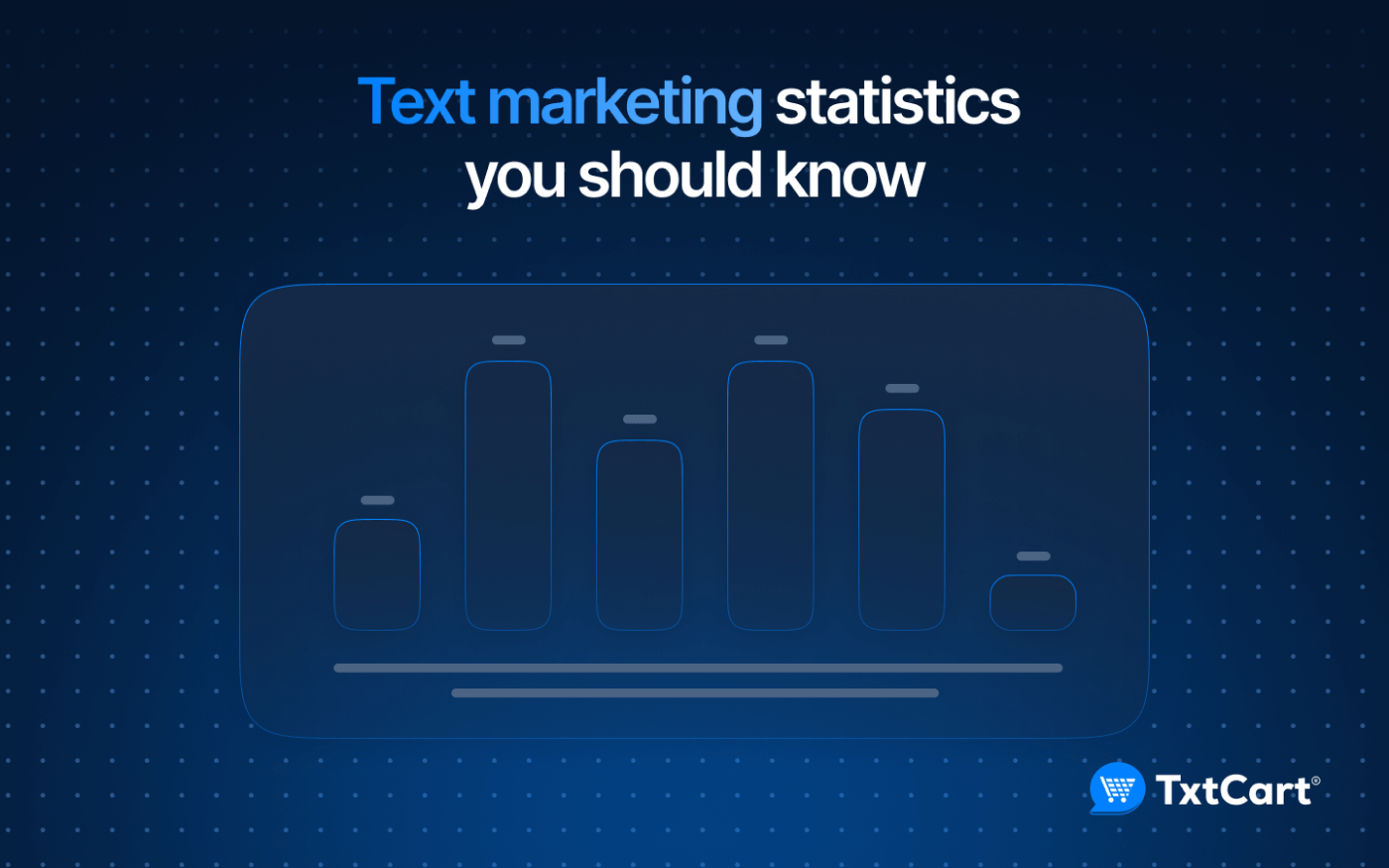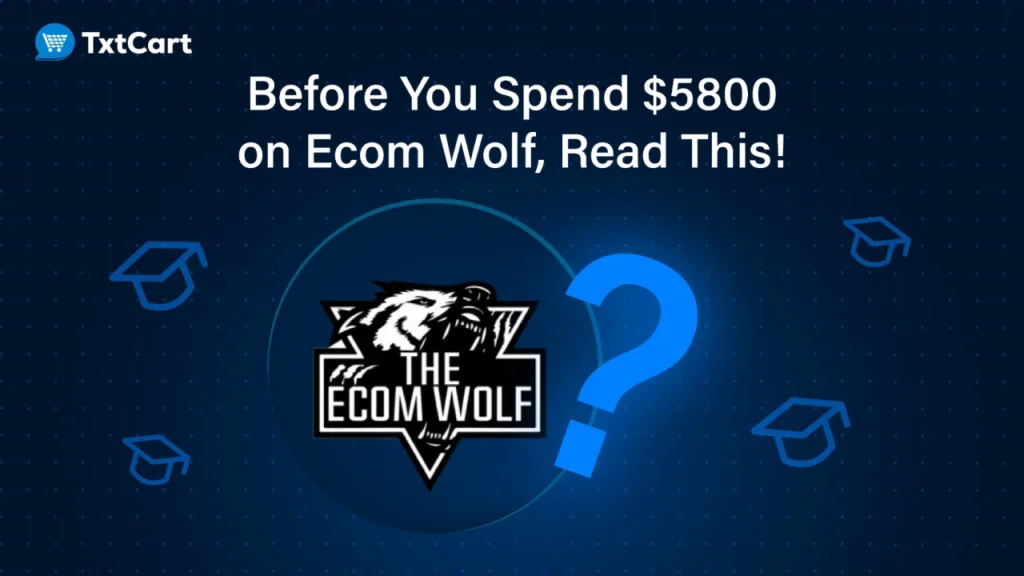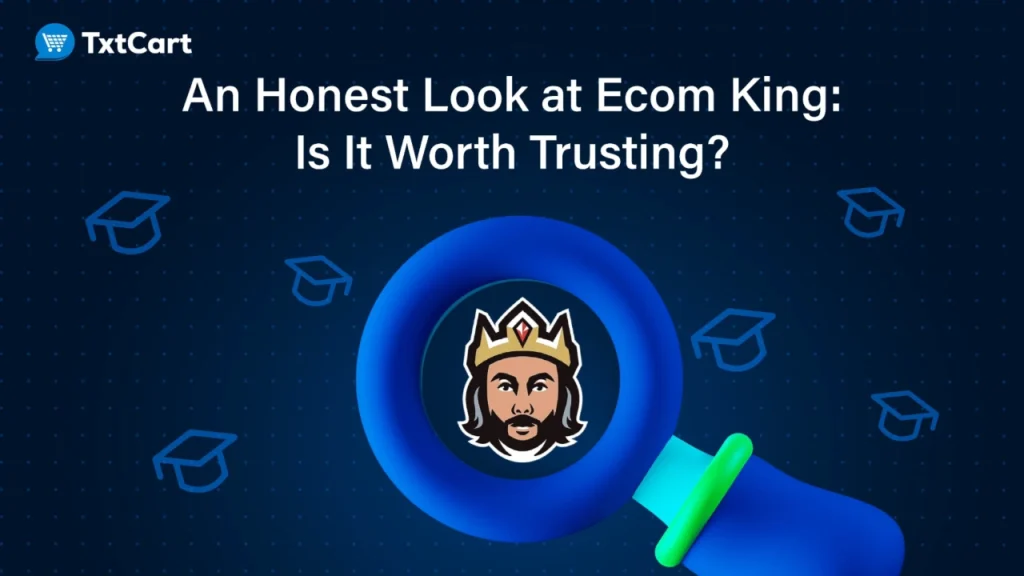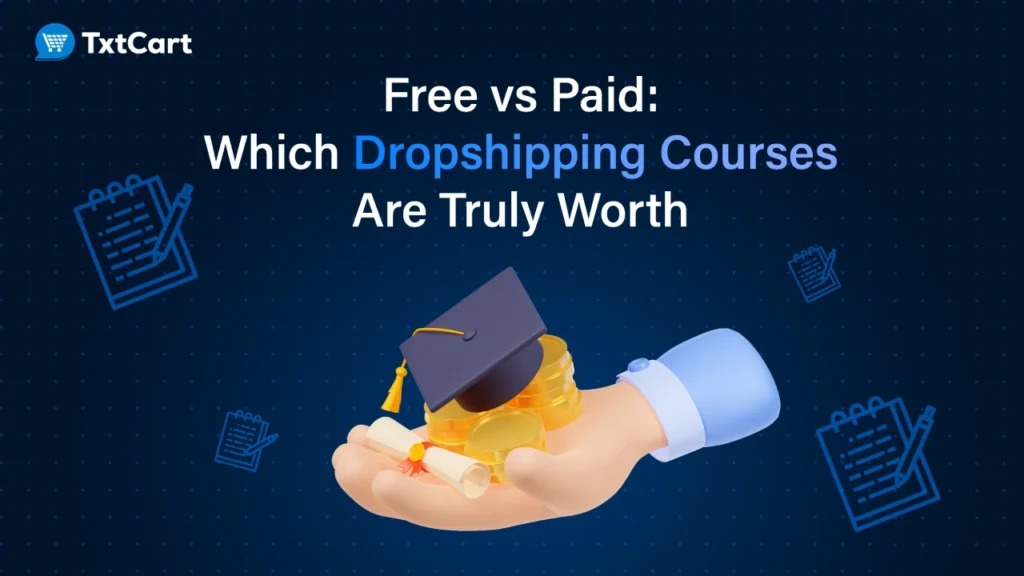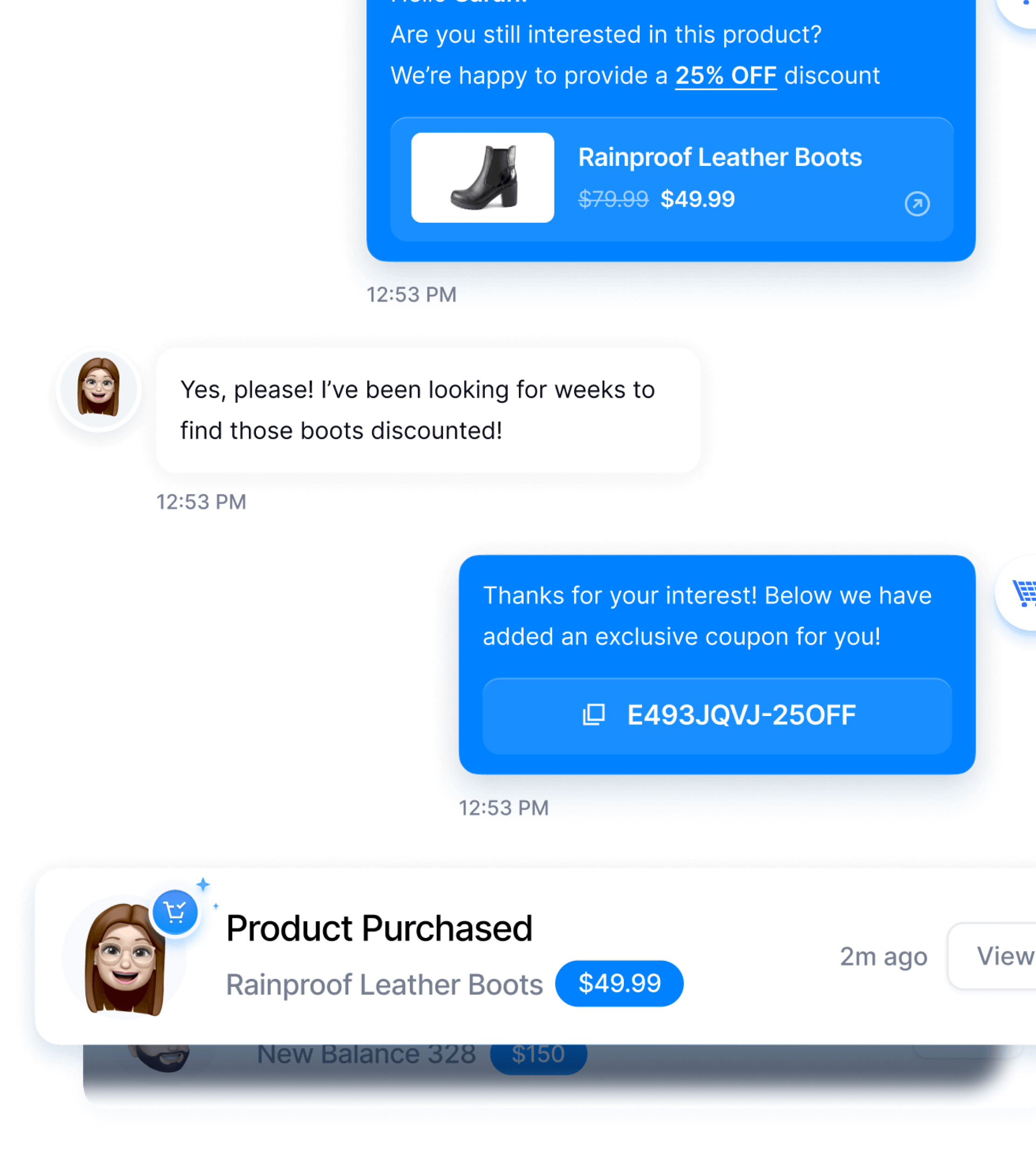If you had a 98% chance of being seen, would you take it?
That’s the power of SMS — open rates for text messages are as high as 98%, and response rates are 5x higher than email or phone calls. It’s fast, personal, and cuts through the noise like no other marketing channel.
But with consumer habits shifting and tech evolving, what worked last year might not work in 2025.
How often should you be marketing text messages? What text messages do customers actually want? When is the best time to send? We’ve got the answers backed by fresh, eye-opening data.
Here’s what you’ll discover:
- Key SMS marketing statistics and growth metrics shaping SMS marketing stats in 2025
- What types of messages drive conversions (and which ones make people unsubscribe)
- How timing, frequency, and personalization impact performance
Ready? Let’s go.
Executive Summary
SMS marketing campaigns continue to dominate as one of the most impactful SMS communication channels in 2025. With 98% open and 45% response rates, it outperforms direct mail, social media, and other digital marketing methods.
Businesses are increasingly leveraging AI and automation to optimize campaigns, while personalization remains a top driver of engagement and conversions.
Here’s the overview of text marketing statistics we have covered in the guide:
Key Findings:
- 5 billion people globally use SMS, covering 65% of the world’s population (Statista, 2023).
- 73% of SMS marketers report SMS drives incremental revenue, boosting AOV and customer lifetime value (Attentive).
- The global SMS marketing market is projected to hit $38.4 billion by 2030, growing at a 20.8% CAGR (Grand View Research).
- AI-powered chatbots handle 47% of service requests, improving response times by 92% (HubSpot).
- 60% of holiday shoppers prefer SMS for Black Friday and Cyber Monday deals, driving peak revenue periods (Whop).
Emerging Trends for 2024–2025:
- Increased adoption of AI and automation, with 47% of brands planning to expand AI use for personalized SMS workflows (TxtMagic).
- Focus on compliance with regulations like TCPA and GDPR, ensuring responsible marketing practices.
- Enhanced rich media messaging (MMS) for 20% higher engagement rates compared to plain SMS (SignalWire).
- Growth in interactive SMS tools, including polls and surveys, to improve two-way communication (SimpleTexting).
Critical Changes from Previous Years:
- SMS has shifted from a transactional tool to a personalized marketing channel, leveraging AI-driven insights for better segmentation.
- Businesses are increasingly integrating SMS with email and omnichannel marketing to boost ROI by 20–30% (G2).
- Consumers demand frequency control, with 81% unsubscribing due to message overload (Optimove).
As mobile phones and businesses shift toward AI-driven personalization and omnichannel strategies, finding the right SMS marketing software is key to maximizing ROI and both customer satisfaction and engagement.
Ready to boost revenue with SMS marketing? Discover how Haute Home LA achieved $40,695 in 30 days and a 35.46x ROI using TxtCart’s AI-powered SMS platform to recover abandoned carts and drive conversions.
Haute Home LA, a luxury home decor brand, added $15,000 in sales in their first 5 days of setting up TxtCart’s 2-way SMS, with a 37.5% reply rate and an average order value of $1,937. 30 days later this turned into $40k+ revenue.
$40,695
Added Revenue in 30 Days
35.46x
SMS Attributed ROI
32%
Checkouts Recovered

“The decision to switch to TxtCart has been transformative for our business.Their AI-driven approach has recovered lost sales and significantly enhanced customer engagement. It’s been a game-changer for us.”
CEO, Haute Home LA
Latest SMS Marketing Statistics
The adoption of SMS marketing has surged due to increased mobile phone usage, industry demand, and the undeniable ROI that text-based marketing delivers.
Here’s a look at key customer data and SMS marketing statistics points shaping SMS marketing’s role in business communication increase customer engagement on messenger apps.
1. General Usage & Adoption
- Global SMS Reach – 5 billion people worldwide send and receive text messages, covering 65% of the global population. (Statista).
- Open Rates – Text messages boast a 98% open rate, making them one of the most reliable than other communication channels. (Gartner)
- Smartphone Users – 83.7% of the global population owns a cell phone, and 91% of U.S. adults have SMS-enabled mobile devices. (Pew Research)
- Business Adoption Rates – 61% of businesses use SMS marketing messages, and 70% of marketers rely on SMS as a critical part of their SMS marketing strategy. (Klaviyo, WP Forms)
- Growth Trends – The SMS marketing market size is projected to grow to $9.96 billion by 2030 at a CAGR of 20.8%, with 52% of marketers increasing their budgets in 2023. (Attentive)
- Industry-Specific Adoption – Retail dominates SMS usage, while healthcare is the fastest-growing adopter, leveraging SMS for appointment reminders. (Grand View Research)
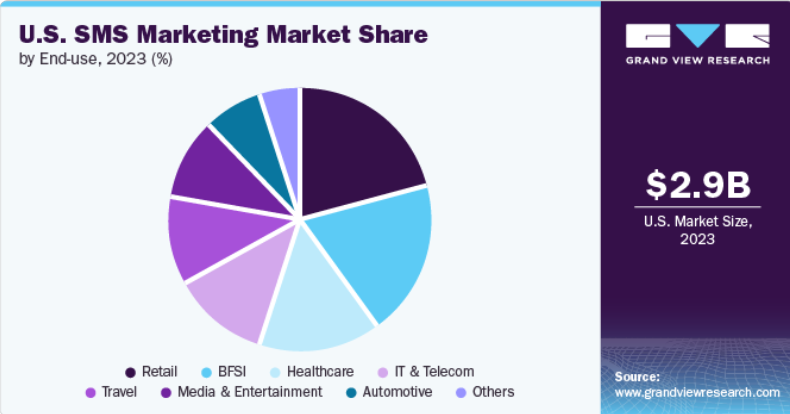
2. Consumer Behavior & Preferences
- Daily Phone Use – Americans check their phones an average of 352 times per day—once every 2 minutes and 43 seconds, while some said their addiction of checking phone 205 times a day (Asurion, Reviews.Org)
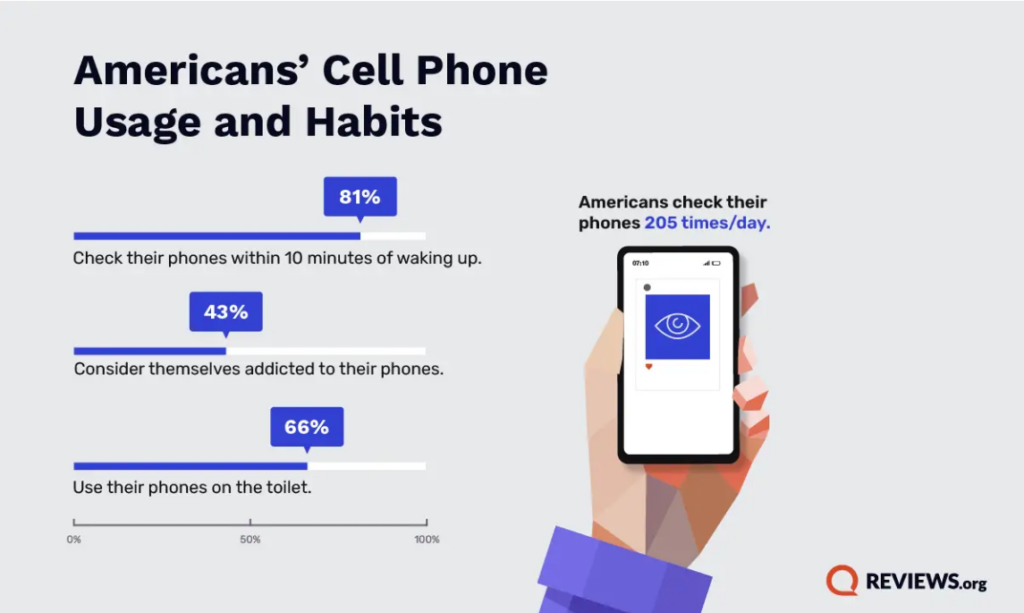
- Message Response Times – 90% of text messages are read within 3 minutes, and the average response time is 90 seconds—faster than email’s 90 minutes. (Adobe, Forbes)
- Channel Preferences – 69% of consumers prefer texting over email for time-sensitive updates, and 91% opt-in to use SMS marketing, demonstrating trust in the channel. (D7 Networks, TxtMagic)
- Age Group Behaviors – 95% of people aged 18–29 and 91% aged 30–40 prefer texting as their primary marketing channel. (CallHub, TxtMagic)
- Shopping Patterns – 73% of consumers have made a purchase after receiving SMS marketing messages, with peak conversion rates occurring at 8 AM–11 AM and 5 PM–8 PM. (Recart, Attentive)
- Engagement Activity – SMS marketing messages boasts a 29% average conversion rate, outperforming email at 18%. (TxtMagic)
Read next:
3. Engagement Metrics
- Open Rates – SMS messages have an average open rate of 98%, far surpassing email’s 20% open rate. (Gartner, Finances Online)
- Response Times – 95% of text message marketing are read within 3 minutes, with an average response time of 90 seconds—significantly faster than email’s 90 minutes. (D7 Networks)
- Click-Through Rates (CTR) – SMS campaigns achieve 19–36% CTRs, outperforming email’s 2–5% average click-through rates (CTRs). (Txtellent, XL Today)
- Conversion Rates – SMS boasts conversion rates of 21–32%, far higher than email marketing’s 18%. (SimpleTexting, Postscript)
- Unsubscribe Rates – 73% of consumers unsubscribe when they receive SMS messages too many times in a single week. (Klaviyo, WinSavvy)
- Cart Abandonment Recovery – 70.19% of online carts are abandoned, but SMS recovery messages achieve an average click through rate of 20–35%, helping recover lost sales. (Baymard Institute) 48% of shoppers abandon carts due to extra costs (shipping, taxes, and fees), making price transparency critical.
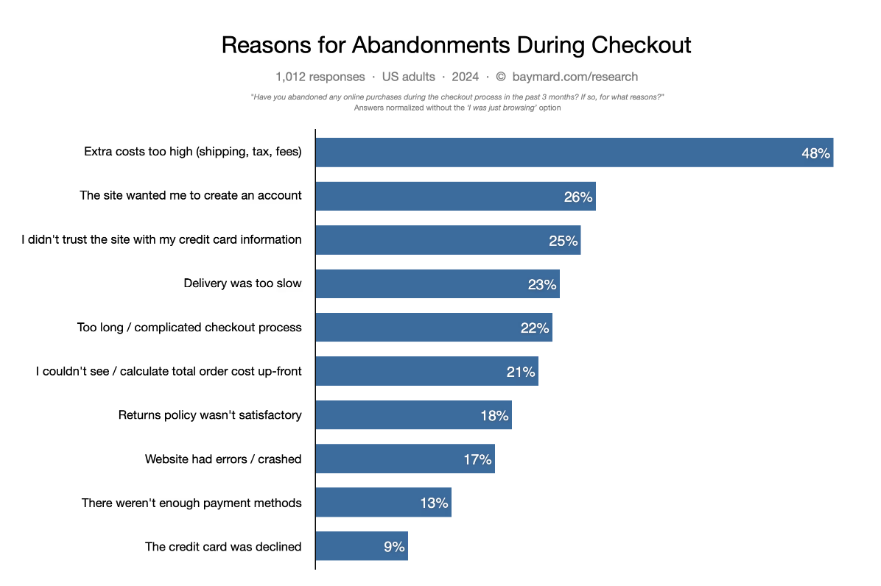
E-commerce businesses in the US and EU lose an estimated $260 billion in sales each year due to cart abandonment. Optimizing checkout flow and design could recover up to 35.26% of these lost orders. (Baymard Institute)
Want to set up SMS-based checkout recovery for your store?
Read our step-by-step guide on optimizing checkout flows for SMS reminders and start recovering abandoned carts today.
TxtCart’s AI-powered cart recovery helped Toroe Eyewear recover 345 orders in 8 months, generating over $60K+ in additional revenue with an 8.32% increase in sales.
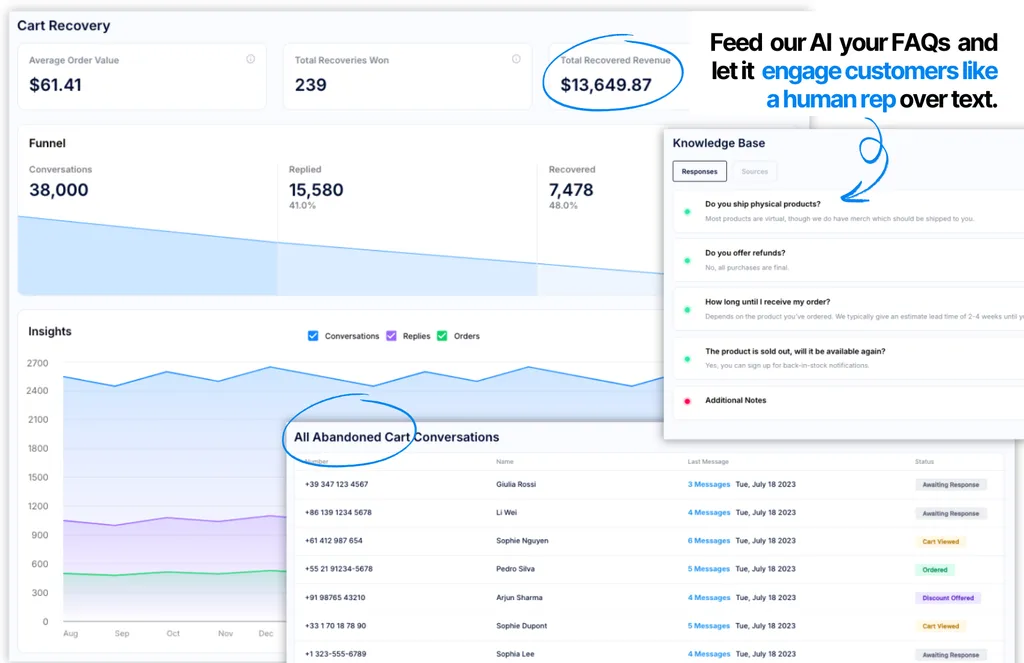
With 3,489 total conversations and a 41.23% reply rate, TxtCart proved the impact of personalized SMS marketing for abandoned cart recovery.
Toroe Eyewear, a premium performance eyewear brand, used TxtCart’s 2-way SMS to generate $60,382 in revenue, with over 3,400 conversations and a 41.23% reply rate, boosting sales and recovering 800+ orders in 8 months.
$60,382
SMS Attributed Revenue
24.8x
SMS Attributed ROI
800+
Recovered Orders

“Hands down the best SMS Marketing platform we have used thus far. TxtCart allows us to scale our advertising with the profits it generates and has been extremely user-friendly and easy to set up.”
Founder, Toroe Eyewear
Read next: How to Reduce Cart Abandonment in Your Store (For Good)
4. List Building & Subscription
- Opt-in Motivations –
- 91% of consumers have signed up for SMS programs, citing convenience and accessibility. (Ecommerce Bonsai).
- 48% of consumers say SMS as a channel for brand updates due to its ease of use and accessibility. (GSMA)
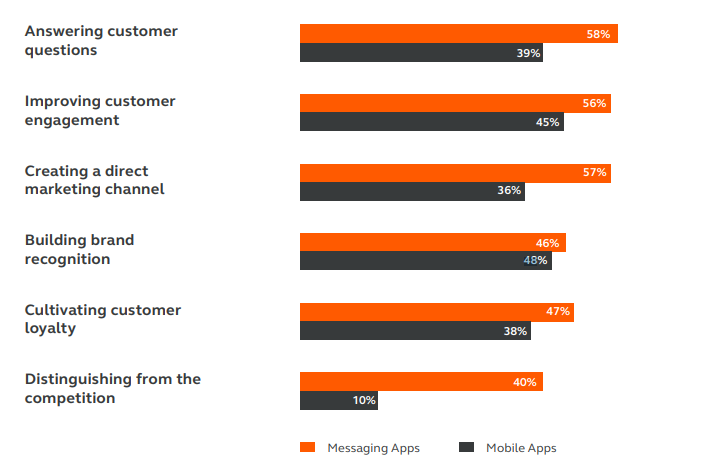
- Subscription Methods – 50 million people globally have opted into using SMS marketing, especially in retail and healthcare. (ProTexting, SimpleTexting)
- Brand Subscriptions – 52% of consumers are subscribed to 2–3 brands, while 28% subscribe to 4–5 brands, showing openness to SMS engagement. (Klaviyo)
- Unsubscribe Reasons – 73% of users unsubscribe from SMS programs when they receive SMS messages multiple times a day, underscoring the importance of frequency control. (Klaviyo)
- Growth Rates – The U.S. SMS marketing market is projected to grow from $4.98 billion (2020) to $12.58 billion (2025) at a 20.3% CAGR. (Ecommerce Bonsai)
- Churn Metrics – SMS marketing maintains a 2% average opt-out rate, far lower than email’s 20% churn rate, ensuring stronger customer retention. (WinSavvy, G2)
Read next: 5 Ways to Use SMS Marketing for Customer Retention in 2025
5. Campaign Performance
- Revenue Per Message – Abandoned checkout SMS messages generate $3.46–$10.05 RPM (Revenue per Message), delivering high ROI. (Attentive)
- ROI Statistics – SMS marketing achieves an average ROI of $71 per $1 spent and can scale up to 500% ROI, outperforming other digital marketing methods. (Textellent, WinSavvy)
- Frequency Preferences – 42.4% of consumers prefer receiving 4–6 SMS per month, while 19% are open to daily messages, showcasing varied frequency preferences. (Thrive MyWay, Drip)
- Personalization Impact – 49% of consumers say sharing data for personalized SMS, and 63% of marketers saw higher conversions due to personalization, demonstrating the power of data-driven SMS marketing strategies. (Attentive, Statista)
- A/B Testing Results – Testing different SMS elements (CTAs, timing) can boost conversion rates by 20%. (VWO).
Read next: 15+ Text A/B Testing Examples for SMS Marketing
6. Message Types & Effectiveness
- Promotional Performance – Promotional SMS marketing campaigns achieves an average open rate of 98% and a 36% click-through rate (CTR)—8x higher than email. (Klaviyo, CM)
- Transactional Stats – Order updates and confirmations via SMS reduce customer inquiries by 47% and achieve 72% preference rates over email. (HubSpot, CallHub)
- Cart Recovery Rates – E-commerce SMS reminders recover 35.26% of abandoned carts with 20–35% CTRs, outperforming email recovery rates of 1–10%. (Baymard Institute, Textline)
- Order Confirmation Engagement – 72–75% of consumers use SMS marketing for order confirmations, delivery tracking, and shipment alerts. (HubSpot, D7 Networks)
- Customer Service Metrics – 89% of consumers say conversational SMS for support, and 70% of leaders credit AI chatbots for improving service efficiency. (Forbes, Zendesk)
- Special Occasion Impact – SMS promotions during events like Black Friday deliver up to 2000% ROI and 41% subscriber growth during holiday seasons. (Enterprise Apps Today, Notifyre)
Maximize seasonal sales with TxtCart.
Joyride, an LA-based dog harness brand, used TxtCart’s 2-way SMS to recover abandoned carts and drive $1.84M in revenue, achieving a 12.4x ROI and facilitating over 23,600 sales during key shopping events.
Make every event a revenue driver—see how TxtCart can help SMS marketing work for you.
How much revenue could you add from SMS marketing? 🤔
Use our revenue calculator to find how many more sales you could be driving from your SMS marketing campaigns with TxtCart.
7. Cross-Channel Integration
- SMS vs. Email Comparison – SMS boasts an 82% open rate compared to 21% for email and delivers a 45% response rate, outperforming email’s 8% response rate. (G2, Forbes)
- Multi-Channel Results – Combining SMS and email increases open rates by 20–30%, while 85% of interactions are expected to be handled without agents using AI-powered solutions. (G2)
- Platform Statistics – The SMS marketing market was valued at $2.86 billion in 2023 and is expected to grow at 20.8% CAGR through 2030. (Grand View Research)
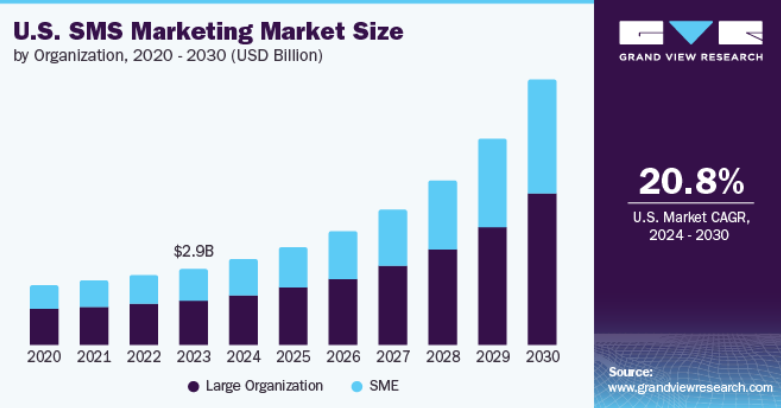
- Channel Preferences – 91% of consumers prefer SMS for reminders and updates, and 44% prefer SMS over email for faster responses. (G2, Forbes)
- Combined Strategies – Follow-up SMS after email boosts engagement by 20–30%, with 56% higher ROI for businesses using multi-channel marketing. (WinSavvy)
8. Industry-Specific Performance
- Retail Metrics – Retail SMS marketing achieves 6–8x higher engagement rates than email. 56% of retailers plan to increase SMS budgets due to its high ROI. (Retail Dive, FinancesOnline)
- Healthcare industry – 60% of millennials prefer SMS for appointment reminders, and 54% rely on SMS for scheduling updates, reducing no-shows. (WinSavvy)
- Banking Data – 46% of financial institutions increased SMS spending for alerts and security updates, with 90% of SMS read within 3 minutes. (G2)
- Real Estate – 73% of real estate businesses use SMS for scheduling property viewings, reminders, and follow-ups, leveraging 82% open rates. (G2)
- Education – 47% of schools use SMS for class schedules, fee reminders, and event updates, improving attendance and parent communication. (WinSavvy)
- Service Industry Performance –
- Entertainment & Leisure: 63% of businesses use SMS for event promotions and ticket bookings. (FinancesOnline)
- Construction: 57% rely on SMS for project updates and delivery scheduling. (FinancesOnline)
- Utilities: 53% of companies send SMS alerts, with 90% of messages read within 3 minutes. (FinancesOnline)
- Logistics: 50% of logistics companies use SMS for delivery tracking and ETA updates. (FinancesOnline)
- Nonprofits: 50% of nonprofits use SMS for fundraising and donor engagement. (FinancesOnline)
- Automotive: 48% of automotive businesses use SMS for reminders and test-drive scheduling, reducing no-shows by 26%. (FinancesOnline)
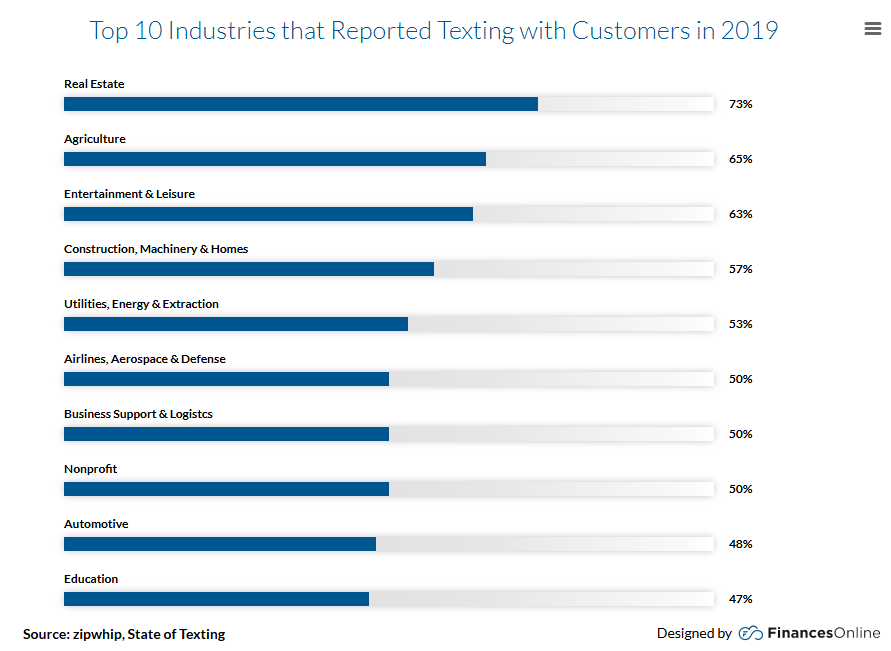
9. Regional Differences
- North America – SMS is the preferred channel for 30% of consumers, compared to 24% globally. The U.S. SMS market was valued at $16.5 billion in 2022 and continues to grow with high mobile adoption rates. (Klaviyo, Statista)
- Europe – 46% of Europeans subscribe to 4+ SMS lists, showcasing strong brand loyalty. 23% made 4–5 purchases via SMS last year—higher than North America and APAC. (Klaviyo)
- APAC (Asia-Pacific) – APAC controls 30% of the SMS market, led by China and India. 66% of APAC consumers prioritize discounts for SMS sign-ups but prefer only 1 message per week. (Statista, Klaviyo)
- Emerging Markets – SMS is vital in India and China due to high populations and limited internet reliance, making it a primary mobile communication channel. (Statista)
Compliance Variations
- TCPA Compliance (North America)
- The TCPA (Telephone Consumer Protection Act) in the U.S. restricts SMS marketing to 8:00 AM–9:00 PM in the recipient’s local time zone.
- States like Florida enforce stricter rules, limiting messages between 8:00 AM–8:00 PM.
- GDPR Regulations (Europe)
- GDPR laws require explicit opt-in consent for SMS marketing. Brands must clearly outline data usage policies and offer easy opt-out rate at any time.
- Quiet Hours (Global)
- Platforms like TxtCart enforce quiet hours, automatically pausing messages during 8:00 PM–8:00 AM in most regions.
- Countries like France prohibit SMS marketing on Sundays and public holidays.
- APAC Restrictions
- Markets like Australia and New Zealand follow 8:00 AM–8:00 PM restrictions.
- India and China enforce specific time-based rules, prioritizing compliance with data privacy laws.
- Smart Sending
- Platforms use Smart Sending tools to pause texts during restricted hours and queue them for later delivery, ensuring compliance without manual intervention.
Automate compliance and boost engagement with TxtCart.
CROSSNET used TxtCart’s 2-way SMS text marketing, to generate $453,185 in revenue, recover 3,000+ orders, and achieve a 17.6x ROI in just 8 months.
Discover how TxtCart simplifies compliance and scales your mobile apps for SMS marketing success.
10. Technical Performance
- Delivery Rates – SMS messages have a 98% delivery rate, and 90% are read within 3 minutes, making SMS one of the most reliable marketing channels. (Source: Txtellent)
- Message Size Impact – Messages within the 160-character limit see higher delivery and response rates, while multi-part messages can increase costs and reduce readability. (Infobip)
- Link Performance – SMS links achieve 36% click-through rates (CTR), significantly higher than email CTRs (2–5%). Adding branded links improves trust and visibility by up to 39%. (Drips)
- Rich Media Stats – MMS messages with images and videos increase engagement by 250% and conversions by 20–30% compared to plain-text SMS. (Converted)
- API Integration – Advanced APIs allow seamless integration with CRM systems, enabling personalization and trigger-based campaigns for better targeting. (Source: SignalWire)
- Platform reliability – Modern SMS marketing platforms guarantee 99.9% uptime, ensuring messages are delivered without delays even during high-traffic events like sales and promotions. (Source: Twilio)
Want to make the most out of your marketing efforts? Read our beginner guide to Shopify SMS marketing.
11. Customer Service & Support
- Response Expectations – 82% of customers expect immediate issue resolution, making fast responses a critical factor for satisfaction.
- Resolution Rates – 77% of leaders predict about SMS marketing statistics that a well-curated SMS and email marketing strategy with AI will resolve the majority of customer service tickets without human intervention by 2025.
- Satisfaction Scores – Companies using AI-powered tools report a 92% improvement in response times and 83% higher customer satisfaction due to faster issue resolution.
- AI vs Human Stats – 54% of service reps prefer AI to assist in handling complex issues, while 19% believe AI-only models should manage tickets.
- Support Efficiency – AI chatbots handle 47% of service requests, reducing staff workload and enabling 24/7 availability for customer queries. (Source: HubSpot)
- Channel Preferences – 15% of customers prefer AI chatbots and online chat as their top support channels, followed by 9% for mobile phones be it receiving phone calls and messages, and 8% for email and social media.
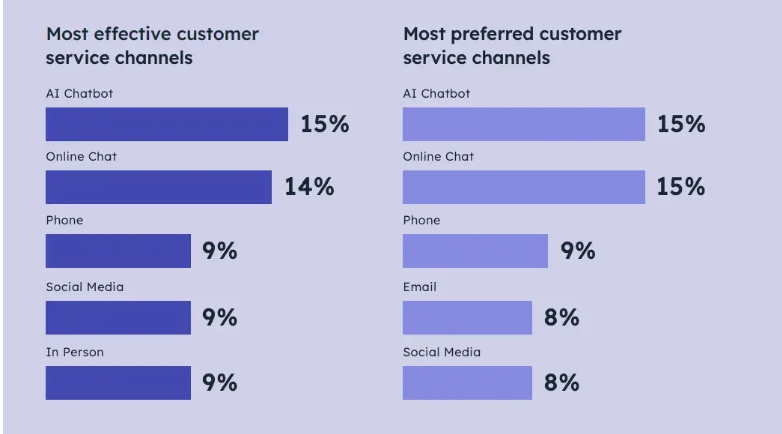
12. Compliance & Privacy
- Oup-out Data – SMS campaigns report less than 5% average opt-out rates, compared to email’s 20% annual churn rate. (WinSavvy)
- TCPA Compliance – The TCPA in the U.S. mandates SMS sending between 8 a.m.–9 p.m., with stricter limits like 8 a.m.–8 p.m. in states like Florida. (Klaviyo)
- GDPR Impact – In Europe, GDPR enforces explicit opt-in consent and requires brands to provide opt-out options at any time. (GDPR Guidelines)
- Privacy Concerns – 63% of consumers worry about privacy with AI-driven SMS systems, emphasizing secure data handling. (HubSpot)
- Consent Management – 90% of businesses use double opt-in systems to ensure compliance with privacy laws and subscriber consent. (HubSpot)
Read next: The Ultimate Guide to SMS Opt-in for 2025 (Tips + Examples)
13. Cost & ROI Analysis
- Message Costs – SMS pricing starts at $0.015 per message in the U.S. and Canada, with additional charges for Unicode messages or exceeding 160-character limits.
- Acquisition Expenses – Sending SMS campaigns to 1,000 contacts costs approximately $15, making SMS a cost-effective acquisition tool compared to email and paid ads.
- Lifetime Value – 73% of marketers report incremental revenue from SMS, with 30% noting increased average order value (AOV) and customer lifetime value (LTV).
- Industry ROI – SMS marketing generates an average ROI of $73 for every $1 spent, outperforming most marketing channels. E-commerce brands saw a 27x ROI and a 230% increase in sales volume through SMS campaigns.
- Platform Comparison – SMS campaigns achieve click through rate (CTR) of 10.66%—much higher than email’s 1.23% CTR—and SMS open rates of 98% far exceed email’s 20%. (Source: MarketingCharts, Business2Community.com)
- Investment Returns – 92% of companies report improved engagement and 83% note faster response times after implementing AI-powered SMS platforms, justifying their investment.
- Automated returnsAutomated SMS messages deliver 26% of all orders from just 13% of sends, doubling conversion rates compared to email. (Source: Omnisend, Attentive)
Read next: Strategies to Boost Sales From Your SMS Automation 2025.
14. Future Trends & Projections
- Market Forecasts- As found in Data Bridge research on general SMS marketing statistics, the SMS marketing industry is projected to reach $38.4 billion by 2030, driven by rising adoption across sectors like e-commerce, retail, and healthcare.

- Technology Adoption – 52% of marketers plan to increase investment in SMS marketing tools, focusing on automation, personalization, and AI-powered messaging platforms. (G2)
- AI Integration – 90% of businesses say AI chatbots effectively handle customer requests, with 77% predicting AI will resolve most tickets without human involvement by 2025. (HubSpot)
- Automation Growth – Automated SMS drives 26% of all SMS orders from just 13% of sends, showcasing its efficiency in nurturing leads and improving conversions. (Omnisend)
- Investment Trends – 73% of marketers reported incremental revenue growth through SMS, with 30% boosting average order value and LTV. SMS remains a top 3 revenue-generating channel for businesses. (Attentive)
- Platform evolution
- 47% of brands are expanding their use of AI for personalized text messages, improving segmentation and timing (TxtMagic).
- Adoption of chatbots (35%) and interactive polls (31%) signals a shift toward engagement-focused messaging (SimpleTexting).
Leverage TxtCart’s AI-powered tools to deliver and send personalized messages in SMS campaigns, automate SMS segmentation, and boost engagement—just like brands achieving double-digit ROI with smarter messaging strategies.
Read next: SMS Marketing Strategies Using Consumer Psychology to Drive Purchase Decisions
15. Consumer Psychology
- Trust Factors – 85% of consumers are more likely to trust SMS messages from brands they’ve opted into, reinforcing the importance of consent-based marketing. (Attentive)
- Purchase Motivation – 65% of SMS purchases are impulse-driven, with customers buying items earlier than planned due to promotional text message marketing. (Texting.io)
- Message Fatigue – 81% of U.S. consumers unsubscribe from brands that send too many messages, stressing the need for frequency control to avoid opt-out.(Optimove)
- Emotional Response – 75% of business leaders believe personalization is critical to success, and 89% of professionals claim customers expect it—making personalized SMS campaigns key to boosting engagement and satisfaction. (Optimove)
- Loyalty Metrics – 49% of Gen X and 44% of Gen Z actively prefer SMS communication, highlighting its role in building customer loyalty across age groups. (Statista)
Read next: 5 Ways to Use SMS Marketing for Customer Retention in 2025.
16. Device & Platform Statistics
- OS Breakdown – 72.04% of SMS traffic comes from Android devices, while 27.49% is from iOS users, highlighting the dominance of Android.
- Device Performance – SMS marketing messages achieves a 98% open rate, outperforming email and app notifications (Txtellent).
- App vs Native Messaging – 48% of consumers prefer SMS over app notifications, valuing its simplicity and reliability (Klaviyo).
- Rich Messaging – MMS campaigns (with images and videos) see 20% higher engagement rates compared to plain-text SMS (SignalWire).
- Platform Preferences – 15% of consumers prefer AI chatbots for SMS, followed by 14% for online chats, signaling a shift toward automation and real-time assistance (HubSpot).
Read next: Generative AI for SMS Marketing (2025).
17. Seasonal & Time-Based Trends
- Holiday Performance – 60% of holiday shoppers make purchases through SMS promotions during Black Friday and Cyber Monday, driving peak revenue spikes. (Whop)
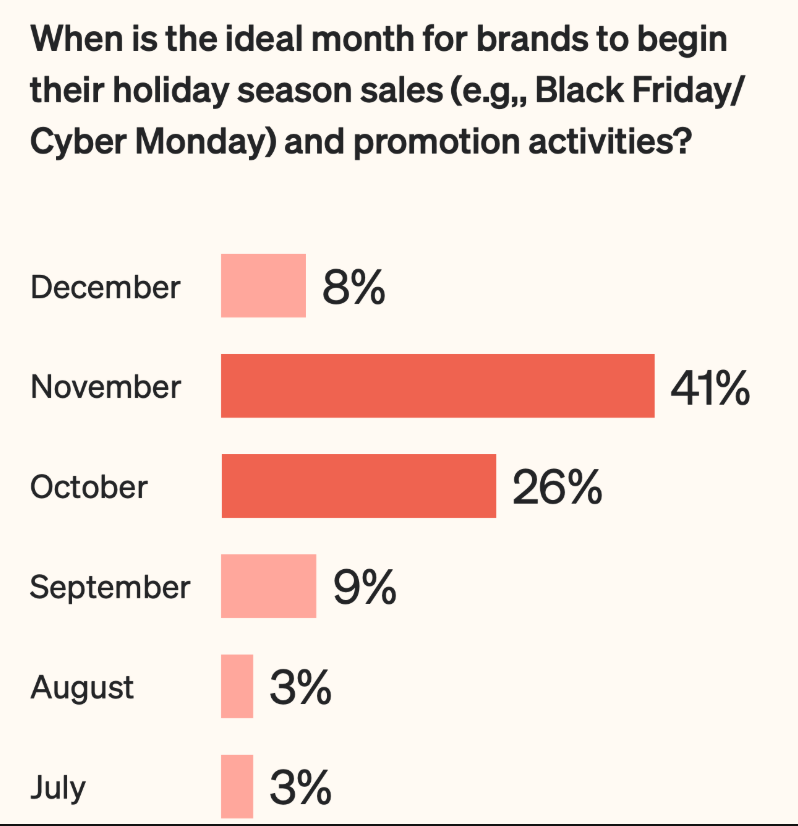
- Time of Day Impact – 45% of SMS purchases occur in the evening, while 25% happen in the afternoon, making evening campaigns the most effective. (Klaviyo)
- Weekly Patterns – SMS campaigns sent on Tuesdays and Thursdays show higher response rates, with Wednesday being the best day for time-sensitive promotions. (Attentive)
- Seasonal Variations – SMS open rates peak during holiday sales seasons, especially in Q4, reflecting seasonal buying patterns.
- Timing Optimization – Messages sent between 12 p.m. and 6 p.m. yield the highest conversion rates, aligning with lunch breaks and evenings. (Attentive)
Read next: The Best Time to Send SMS Marketing Messages in 2025.
18. AI & Automation Impact
- Adoption Rates – 47% of businesses plan to increase AI usage in SMS marketing, leveraging it for personalization and automation to improve efficiency. (Attentive)
- Chatbot Effectiveness – 90% of companies using AI chatbots find them effective for resolving customer queries, providing 24/7 support and reducing workload on human agents.
- Response Quality – 86% of customer service leaders believe AI tools have improved response accuracy, leading to faster issue resolutions and better customer experiences.
- Integration Success – 74% of companies state that integrating AI tools with existing SMS platforms has streamlined workflows, enabling smarter segmentation and personalized messaging at scale. (Source: Hubspot)
Read next: The SMS Marketing Master Calendar for 2025
Analysis & Insights
Trend Analysis
SMS marketing continues to evolve as one of the most effective marketing channels, driven by high open rates (98%) and response times averaging 90 seconds (Gartner).
The integration of AI and automation marketing text messages has shifted SMS from simple push notifications to highly personalized and interactive campaigns. In 2024, 47% of businesses increased their AI adoption, enabling smarter segmentation and dynamic messaging strategies (TxtMagic).
Future Predictions
Looking ahead to 2025, SMS marketing is expected to grow at a CAGR of 20.8%, reaching a global market size of $9.96 billion (Grand View Research).
AI-powered personalization and two-way conversational SMS will dominate the landscape, with chatbots and interactive surveys gaining traction to drive engagement (SimpleTexting).
Predictive analytics will also play a key role in digital and marketing strategy and success, helping businesses send personalized messages out at optimal times to improve conversions.
Expert Quotes
Kieran Flanagan, SVP of Marketing at HubSpot, states:
“AI enables businesses to create smarter, 24/7 support systems and targeted campaigns, revolutionizing customer engagement.”
Meanwhile, Bernard Meyer, Senior Director at Omnisend, highlights:
“SMS‘ marketing strategy delivers an unmatched ROI of $73 for every $1 spent, proving its scalability and profitability.”
Industry Implications
The rise of AI-powered SMS platforms is leveling the playing field for small and mid-sized businesses, allowing them to deliver enterprise-level marketing campaigns without the need for extensive resources.
Industries like retail, healthcare, and e-commerce are leading adopters, using SMS to enhance customer retention, have marketing managers drive seasonal sales, and streamline appointment reminders. Businesses must prioritize compliance and frequency control of text messages to maintain trust mobile users and prevent opt-outs.
Implementation Guide
Actionable Tips
- Optimize Timing – Schedule messages based on customer time zones and behavior analytics to boost open and response rates.
- Leverage AI Tools – Use AI-powered platforms to automate workflows, personalize messages, and segment audiences based on behavior.
- Test & Optimize – A/B test elements like CTAs, delivery times, and message content to refine strategies and maximize conversions.
Best Practices
- Prioritize Compliance – Follow TCPA and GDPR regulations for opt-ins and quiet hours to protect customer trust.
- Focus on Value – Deliver exclusive offers, updates, and reminders rather than generic promotions to maintain engagement.
- Monitor Performance – Track metrics like click-through rates (CTR), conversion rates, and unsubscribe rates to measure success and optimize campaigns.
Common Pitfalls
- Over-Messaging – Avoid bombarding customers with frequent messages, which can lead to opt-outs (81%, Optimove).
- Lack of Personalization – Generic messages reduce relevance and impact. Use data-driven insights for tailored communication.
- Ignoring Compliance Rules – Non-compliance with TCPA or GDPR can result in fines and reputational damage.
Success Metrics
- CTR and Conversion Rates – Target rates above 10.66% CTR and 29% conversions to benchmark performance.
- Revenue Attribution – Measure SMS-driven revenue and ROI, aiming for results like 27x ROI seen in case studies.
- Engagement Scores – Monitor reply rates and interactions, especially for 2-way SMS campaigns.
Businesses ready to elevate their SMS marketing strategies can take inspiration from brands leveraging TxtCart to drive revenue and engagement through AI-powered automation and segmentation.
Chaser, a lifestyle apparel brand, generated $125,000 in revenue with TxtCart’s conversational SMS marketing while recovering abandoned carts and maintaining a 14.8x ROI.
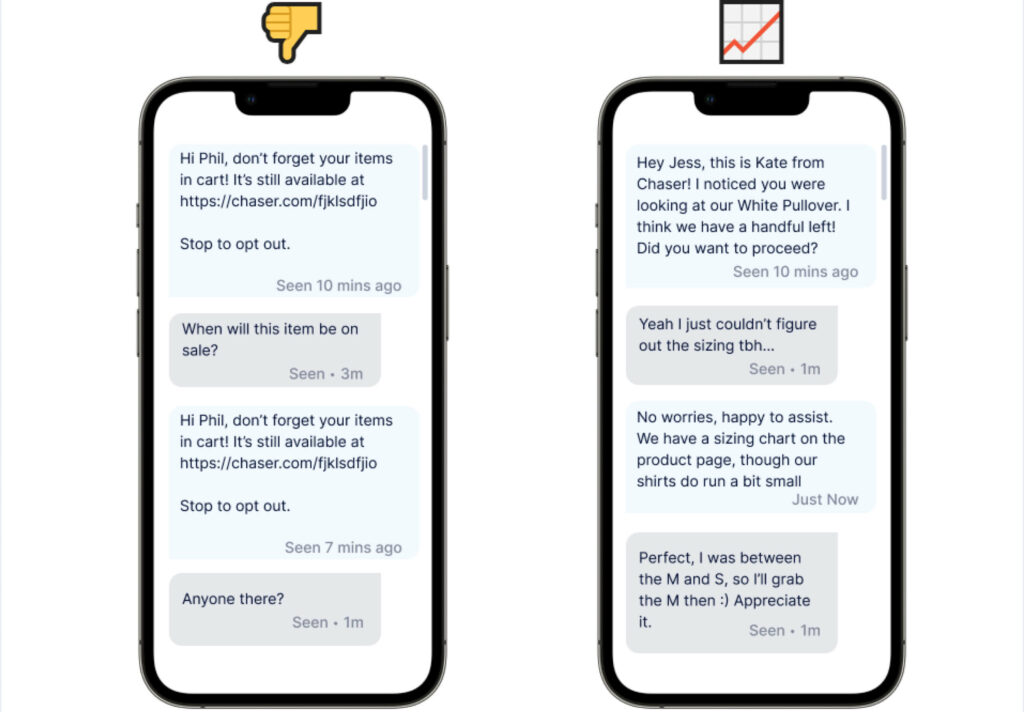
Ready to see similar results?
Discover how TxtCart can transform your text marketing efforts today.
Want to try conversational SMS for free?
Drive more sales with intelligent AI-driven automations that recover carts, engage customers, and streamline flows — saving you 32x in costs. No contracts or minimums.
- Try free for 14 days
- 10x ROI guaranteed
- Join 3000+ Shopify brands
Read next:
